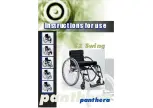
Instructions for use S2 Swing
Instructions for use S2 Swing
3
4
The leg supports
can be rotated inwards, out-
wards, or removed completely from the chair.
To remove the leg support, press the knob on
the inside of the support, see fi gure 2, and lift
the support up and off.
To rotate the leg support inwards or outwards,
press the knob in and twist the support.
Replace the leg support onto the chair by
inserting the tubing of the upper section of the
leg support down into the hole, twist the
support forward and check that the support
locks into position securely so that it can no
longer be twisted or lifted off.
Figure 1.
Button for quick
release hub.
Figure 2.
Knob for removing
the leg support.
Figure 3.
Band for tightening seat
upholstery.
Figure 4.
Screw for the
footrest.
Assembly and dismantling:
When transporting the chair you should remove the
rear wheels and fold down the backrest.
To
remove the rear wheels
, press in the button at
the centre of the hub as in fi gure 1. Then pull the
wheel straight out. To insert the wheels, press in
the button and push the axle into the hole in the
casing. Then push the wheel all the way in, release
the button and pull out to check that the wheel is
securely in place and the button springs back out.
To
fold down the backrest
, pull out the wire
attached to the backrest lock as shown in fi gure 5
and then fold the backrest forward and down.
When you pull the backrest up again you need only
pull it up to full extent and the backrest will lock
automatically when upright.
Adaptation
When adapting the chair to suit your sitting position and provide the mobility you
require, it is important that you make the following adjustments in the correct or-
der. First, adjust the sitting position and after that, adjust the balance of the chair
according to your mobility requirements. The sequence is important since when
you change your sitting position you also change the balance of the chair.
Consider that the effort you put into adapting your chair will provide long-term
benefi ts later on. Try out different adaptations for a few days to make sure you
really have found the best sitting posture and balance of the chair.
You should make the following adjustments
in this order:
1) The tension of the seat upholstery
2) The height of the footrest
3) The tension of the calf band
4) The angle of the backrest
5) The tension of the backrest upholstery
6) The balance of the wheelchair
7) The position of the brakes
1) Tension of the seat upholstery
The rear section of the seat upholstery can be tightened
or loosened by adjusting the Velcro band underneath the
seat as shown in fi gure 3. This allows you to vary your
sitting height by about 2 cm up or down.
2) Height of the footrest
The footrest can be adjusted up or down. Remove the
two screws supporting the footrest on the front of the
frame as shown in fi gure 4, unscrew using a 3 mm
socket head key. Push the end plug down by placing key
19 around the tubing above and tapping down with a
hammer. You will then be able to move the footrest up
or down to fi t into one of the fi ve alternative height po-
sitions. You should adjust the footrest at a height where
your thighs are supported by the seat at the same time as
your feet are supported by the footrest.


























